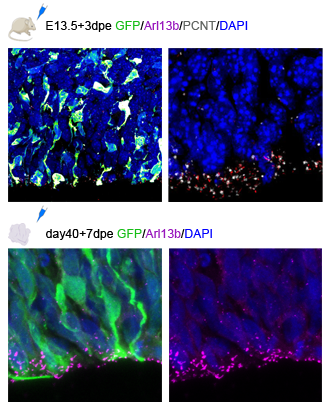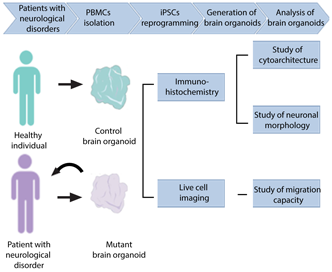Modeling neurodevelopmental disordersThe connection between proper brain development and MCDs cannot be inconsequential since environmental factors and genetic mutations that occur are key elements in such processes influencing the fate and function of the progenitors and neurons. We are focusing on dissecting the role of environmental and genetic factors at the cellular level and try to find common patterns between their function and the potential mechanisms via which they lead to brain disorders. It would be plausible that seemingly completely different molecular, cellular, spatial or temporal functions of several genes will converge on higher-level organization units. Such units – organelles – could serve as organizing centers where genes’ functions will be coordinated in a synchronous way into a common response for modulating brain development. Examples of a brain disorder with diverse phenotypes and genetic causes but with common cellular origin are the ciliopathy syndromes of the CNS, which have been also associated with incorrect brain development and are disorders due to defects in the action of cilia. Cilia are organelles like antennas that are found in most of the cell types in the brain, are known to regulate brain development in mammals and serve as sensory organelles mediating environmental cues. Our goal is to investigate the hypothesis that cilia could play an important role in other brain disorders like MCDs and they would be master regulators of human brain development. |
 |
|
|
|
Modeling neurological disordersNeurological disorders are diseases of the central and peripheral nervous systems and hundreds of millions of people worldwide are affected. Hence, neurological disorder comprise a large burden on worldwide health. Even though a lot of effort was put already into the diagnosis and treatment of such disorders, our knowledge of the mechanisms underlying these neurological conditions is still limited making any effort for designing novel therapeutic approaches difficult. Towards this direction, we have developed a research protocol for modeling hereditary neurological conditions with the aim to unravel the potential cellular and molecular mechanisms underlying such disorders which eventually will be important for the accurate diagnosis and will enhance the structuring of appropriate treatment. The research focuses on Hereditary Spastic Paraplegia (HSP), Cerebellar ataxia, neuropathy, and vestibular areflexia syndrome (CANVAS) and Parkinson's Diseases, disorders that have not yet been modeled using human-specific models and which are attracting attention due to the increased number of patients identified – especial on the Greek population. |
 |
Methodology |
|
|
Based on the latest advances in stem cell technology it is now possible to generate any cell type by differentiating in vitro human-induced pluripotent stem cells (hiPSCs). This is particularly relevant in the field of neuroscience, given that there is limited access to primary cells from the human CNS and PNS. In detail, the research projects involve the recruitment of patients and healthy individuals suffering from neurodevelopmental or neurological disorders. Then, clinical data from such patients will be collected and evaluated. In addition, patient cells will be collected and they will be used for generating iPSCs through reprogramming. The patient and control iPSCs will be then, used for generating 2D models (neural progenitor and neuronal cultures) and 3D models (brain organoids, assembloids of different brain and peripheral regions) to describe the phenotype, unravel the potential mechanisms and potentially try to develop novel treatment via drug testing. Parallel work on in vivo model systems, like the mouse, will be of great importance for investigating the in vivo molecular and cellular mechanisms contributing to the manifestation of human brain disorders. Analysis of the different model systems include immunohistochemistry, microscopy, FACS analysis and others in order to examine any cellular differences, molecular biology techniques and -omics approaches for the molecular differences and more functional analysis (e. g. electrophysiology) to study the electrophysiological properties of the patient cells. The contribution of the data collected under these research projects will contribute to the inadequate knowledge we have so far on brain-related disorders and will be used for diagnosis and personalized treatment. |
|

